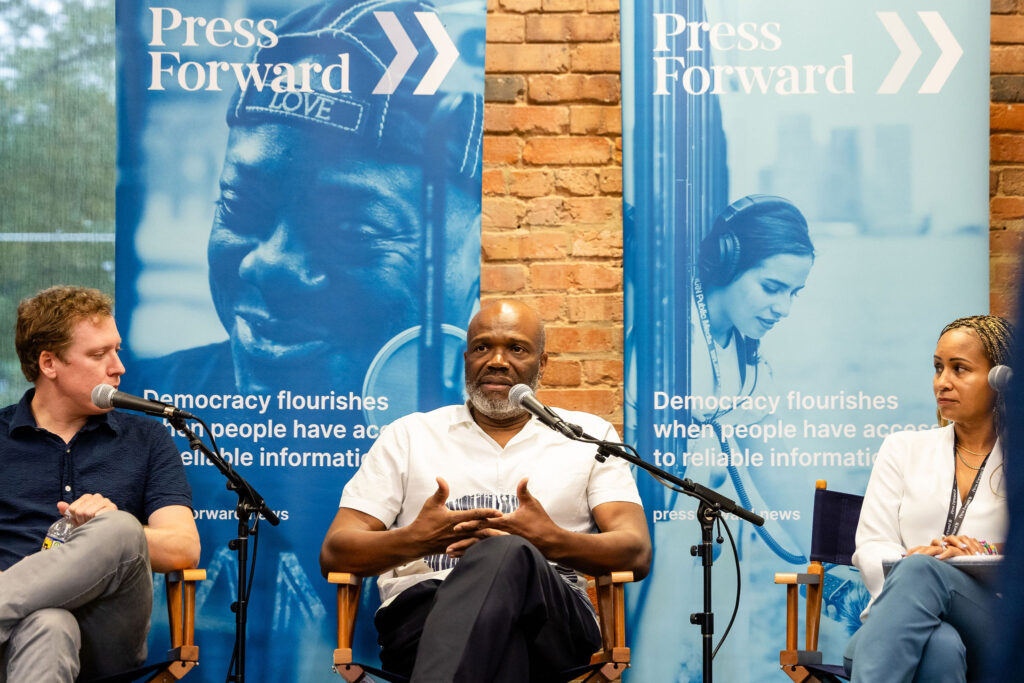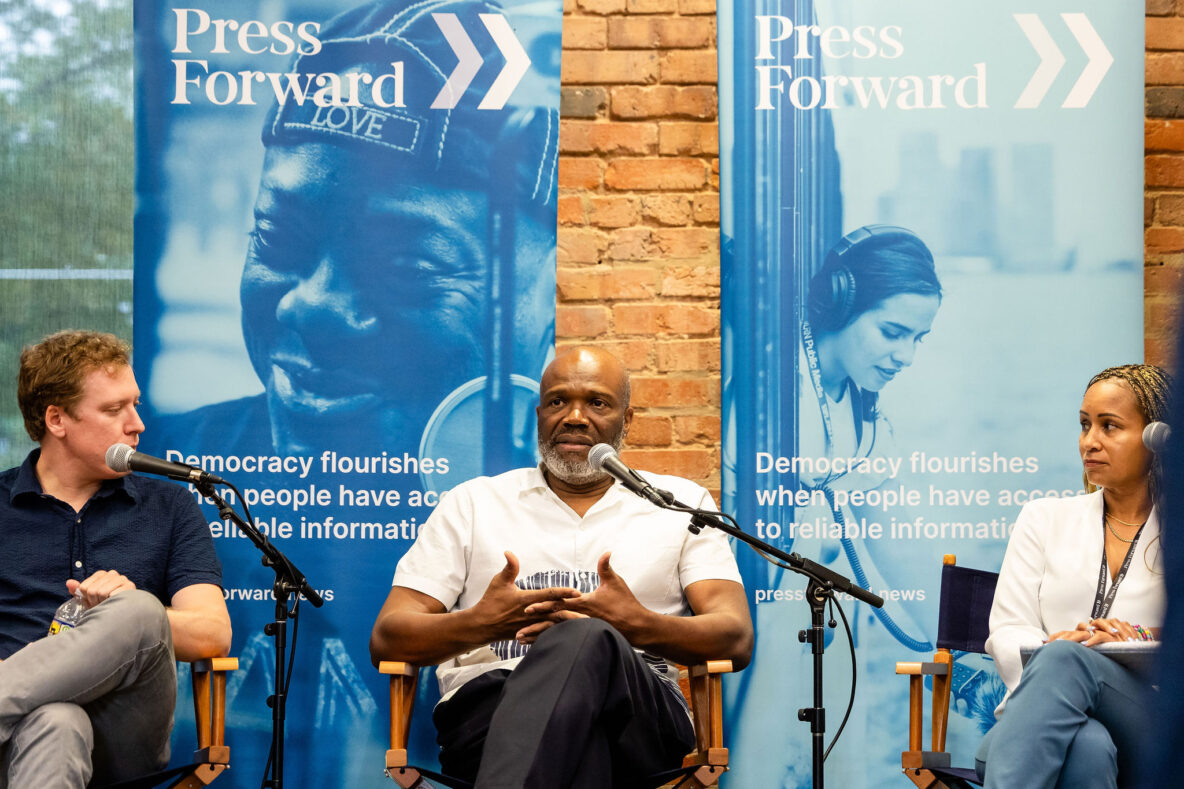
Glenn Burkins, founder of Charlotte’s QCity Metro, speaks at a Press Forward event.
The story of local news has long been told as one of crisis: mass layoffs, shuttered papers, hedge fund takeovers, and news deserts. It’s a compelling narrative, but not always a persuasive one.
While news leaders and funders understand how dire the situation is, that messaging often leads community members to tune out. It’s not that people don’t care; it’s that they feel overwhelmed, anxious, or disconnected when faced with a narrative focused solely on decline.
Fortunately, there’s a better way to make the case for supporting local news. New Press Forward research shows that messages centered on strengthening community — rather than saving the industry — resonate far more deeply.
A perception problem
Press Forward commissioned Beekeeper Group, a strategic communications firm, to analyze how Americans view local news and which messages inspire action. The research included a nationally representative poll of more than 3,000 U.S. adults, along with in-depth interviews, focus groups, and randomized message testing with more than 5,000 participants. Together, the findings offer a clear picture of how people see local news — and how newsrooms can better communicate their value.
“We tested the ‘news desert’ concept, describing communities with few or no reporters,” Alex Dickinson, managing partner at Beekeeper Group, explained. “Over and over, participants said that it made sense but it didn’t move them, and often they said it didn’t reflect their experience.”
Among the most striking takeaways, Americans say they already have plenty of access to local news and information. More than eight in ten respondents reported they could easily find and access trustworthy local information, citing sources like local TV, social media, and community newspapers.
On the surface, this suggests that people don’t see a shortage of access — a view that doesn’t align with the industry’s warnings about news deserts or outlets closing at an alarming rate. In other words: perception doesn’t match reality. Even as newspapers fold and beats disappear, people assume local news is alive and well because they can scroll through Facebook updates or check in with a listserv or neighborhood group. What’s missing, however, is depth, context, enterprise reporting, and fact-checking — the kind of coverage that distinguishes professional reporting from basic, unverified information.
For newsrooms, the lesson is clear: leading with scarcity — using well-worn phrases like “local news is dying” — is unlikely to resonate because most people don’t feel the absence. Appeals are more effective when they highlight quality, depth, and accountability. By shifting the focus from scarcity to service, newsrooms can better align their appeals with the ways people actually experience and value local news.
The findings in action
There are bright spots in the research, too. An overwhelming 87% of respondents said local news matters to them personally. More than nine in ten agreed that local news enhances confidence, builds a stronger community, and supports fair decisions.
The findings are encouraging: people already connect community wellbeing with local news. And while the Beekeeper research is new, several newsrooms have already leaned into that framing — and found success.
- Blue Ridge Public Radio recently launched its Be the Lifeline campaign in response to federal funding cuts. The messaging builds on the station’s crucial role during Hurricane Helene, when BPR partnered with towns to rebroadcast emergency updates, providing the only verified local news source some residents could access for days and even weeks while cell towers and internet were down. “We heard the same phrase over and over again: ‘BPR was a lifeline,’” CEO and General Manager Ele Ellis explained. By centering that message, BPR is reminding listeners of the service they relied on — and asking them to help sustain it.
- Rewire News Group, a nonprofit newsroom covering reproductive and sexual health, rights, and justice, launched The Uplift in 2024 — a monthly newsletter highlighting stories of progress and hope. Designed as a counterbalance to the heavier news cycle, The Uplift quickly became one of Rewire’s most successful fundraising tools, surpassing all other emails in open and click rates. By focusing appeals on solutions and forward-looking wins, Rewire gave readers a chance to be part of progress.
- Arkansas Democrat-Gazette launched its Community Journalism Project in August 2024 with a goal of raising $100,000 in 100 days. They hit that target in just 17. The campaign’s message — “With your contribution, you’re nurturing the growth of a community where facts triumph over fiction and where informed citizens drive positive change.” — clearly resonated. By emphasizing editorial independence and linking directly to stories funded through reader support, the Democrat-Gazette showed how community framing can deliver quick, meaningful results.
Together, these examples show how shifting the frame from saving journalism to strengthening community can unlock stronger support and deeper engagement.
Ways to shift messaging
Framing local news as a community asset isn’t just a tactic for a single fundraising drive — it works best as a throughline in newsroom messaging all year long.
“This shift matters because it changes the entire starting point,” Dickinson said. “Instead of trying to convince people to rescue an industry in decline, we begin with something they already care about: their communities. When local news is described as an asset that strengthens neighborhoods, holds leaders accountable, and helps people make everyday decisions, it suddenly feels less abstract and more essential.”
The Words that Work toolkit is packed with tested approaches, but here are a few to keep in mind:
- Start with impact, not industry. Lead with the tangible ways reporting helps people solve problems, not with the challenges newsrooms face.
- Use “we” language. Frame support as something the community does together — not something people do for journalists.
- Show, don’t tell. Use specific stories, testimonials, or outcomes to demonstrate how reporting makes a difference.
- Connect support to outcomes: Instead of saying “We need your donation,” try, “Your donation helps us investigate water safety” or “Your subscription makes election guides possible.”
- Make it personal: Remind people that reporters live in the same neighborhoods, attend the same schools, and rely on the same information they do.
This framing isn’t just beneficial for fundraising. It also reinforces the purpose of the work for reporters and editors journalists themselves. “For journalists, the shift away from a crisis mindset can be energizing. Framing their work around agency, hope, and possibility taps into why many got into journalism in the first place,” Dickinson added. “It re-centers their mission around building strong communities, telling diverse stories, and helping people solve problems.”
People respond when they see how local news strengthens communities, improves daily life, and helps neighbors look out for one another. Reframing support as a shared investment in the future doesn’t just change how people think about local news — it changes what they’re willing to do to sustain it.
Katie Hawkins-Gaar is a freelance writer and journalism consultant. She previously worked at CNN and the Poynter Institute and now works with a variety of journalism support organizations, including Press Forward, the News Revenue Hub, and Report for America. She lives in Atlanta with her family.


